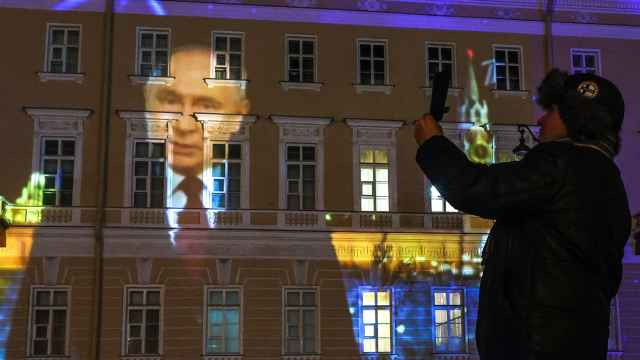A drunken flight navigator contributed to a June plane crash in Petrozavodsk that killed 47 people, with his authoritative instructions leading a less-experienced pilot to attempt a fatal landing in heavy fog, investigators said Monday.
The navigator, Aman Atayev, would seem the least likely culprit in the incident, having logged more than 13,000 hours — 541 full days — on Tu-134 jets. But the Interstate Aviation Committee said his intoxication was one of the factors that caused the crash of the RusAir jet on June 20 in Karelia's capital.
Medical examiners found that Atayev, 50, had a blood alcohol content of 0.081 percent — slightly above the legal limit in Britain and the United States but a violation of Russian piloting rules.
Atayev's recent divorce had driven him to drink, though he never drank before flights, his former mother-in-law, Assya Shumakova, told Rossia-1 television on Monday.
The booze — the rough equivalent to a glass of vodka — caused Atayev, who had worked in civil aviation for more than 30 years, to become more distracted, talkative and assertive, investigators said.
"Normally on a Tu-134, the navigator doesn't do anything during landing," Roman Gusarov, editor-in-chief of Avia.ru, an aviation news web site, said by telephone Monday.
But Atayev's "heightened activity" in the cockpit is clear from the cockpit voice recorder, cited by the aviation agency, which wrapped up its investigation into the incident Monday.
"Sasha, come on, turn it faster!" Atayev told the pilot five minutes before the crash. "I'll lead you right in," he then reassured him. Trusting his navigator, the pilot refused a suggestion from air traffic controllers to abort his first approach.
Atayev also failed to instruct him to search for ground markers at an altitude of 140 meters, and at 110 meters he failed to warn the pilot that he was losing his last chance to pull up, according to the crash report, which is on the Interstate Aviation Committee's web site.
The co-pilot was "effectively" absent from the cockpit during the landing, the report said, without elaborating. It also said the crew's decision not to use certain navigational instruments was among the factors that contributed to the pilot's decision to land.
The pilot was also misled by weather reports that said the clouds would break at 130 meters to 140 meters, when in reality land-based beacons were only visible at 70 meters or less — below the airport's minimum for incoming aircraft, the report said.
Just six seconds before the crash, the pilot calmly said, "I don't see [the beacons] yet, I'm looking." Then the plane hit trees and plowed into a highway 830 meters from the runway. It quickly burst into what one witness said looked like a "pillar of fire."
Locals managed to pull eight people out of the wreckage before the blaze, including a mother and her two children, aged 9 and 14. But the 9-year-old boy and a female survivor later died in the hospital.
The committee's report sheds light on why Russian airlines are the world's most deadly this year, surpassing the war-torn Democratic Republic of Congo, with 119 deaths in eight fatal crashes, including this month's crash that killed most of the Lokomotiv Yaroslavl ice hockey team.
The Karelian crash prompted President Dmitry Medvedev to partially suspend Tu-134 flights. Similar bans have been considered for other Soviet-built planes, including the An-24, after subsequent accidents this summer.
But industry experts and analysts have insisted that the structural problems of Russian aviation are not limited to obsolete aircraft, with poor pilot training and insufficiently enforced safety regulations also serving as contributing factors. The Kremlin recognized these issues after the Lokomotiv crash, ordering a sweeping reform.
The Lokomotiv incident is still being investigated, but pilot error remains among the main versions for the crash. It remains unclear what could have prompted the error.
Drunken crew members have tarnished the safety and reputation of Russian airlines in recent years. In 2009, an S7 pilot was removed from a flight from Germany on suspicion of being drunk.
Later that year, an Aeroflot pilot was removed from a New York-bound plane in Moscow after passengers, including socialite Ksenia Sobchak, accused him of being drunk. The airline later said tests revealed no signs of intoxication and the pilot might have suffered a stroke.
The Investigative Committee confirmed last year that a drunken pilot was to blame for the 2008 crash of an Aeroflot-Nord 737 jet in Perm that killed all 88 people on board.
A Message from The Moscow Times:
Dear readers,
We are facing unprecedented challenges. Russia's Prosecutor General's Office has designated The Moscow Times as an "undesirable" organization, criminalizing our work and putting our staff at risk of prosecution. This follows our earlier unjust labeling as a "foreign agent."
These actions are direct attempts to silence independent journalism in Russia. The authorities claim our work "discredits the decisions of the Russian leadership." We see things differently: we strive to provide accurate, unbiased reporting on Russia.
We, the journalists of The Moscow Times, refuse to be silenced. But to continue our work, we need your help.
Your support, no matter how small, makes a world of difference. If you can, please support us monthly starting from just $2. It's quick to set up, and every contribution makes a significant impact.
By supporting The Moscow Times, you're defending open, independent journalism in the face of repression. Thank you for standing with us.
Remind me later.





